Figure 1

Figure 2
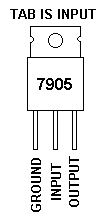
Let's talk to newbies on proper bypassing and surge suppression first by clicking here.
This is a very common problem for newbies when it comes to using a regulator chip. First, remember, this is an analog device, not a digital device. Some digital devices are more efficient due to switching (or buck) but cost more and are somewhat noisy. Analog devices dissipate power (like a resistor) through the solid state substrate of the internal pass transistor in order to reduce voltage levels.
The 78 and 79 series regulators also come in TO-3 cases for larger loads. They also come in different voltages 5 volt, 6 volt, 8 volt, 12 volt, 15 volt, 18 volt, and 24 volt. Typically the input voltage to the regulators should be at least 3 volts higher than the desired output voltage, not to exceed 24 volts (35 volts for the 24 volt device). Study the datasheets for voltages, currents, and temperature not to exceed. As you will see in the information below, you need to keep the input voltage within a range so as not to dissipate too much heat from the regulator.
There are four common problems that cause your regulator to overheat.
1) Improper pin connections.
2) Missing bypass capacitor(s).
3) Excessive dissipation. (Excessive input voltage or excessive current draw.)
4) Insufficient heat sinking.
1) Improper pin connections
Let's take item one. Proper pinout for the 78 or 79 series voltage regulators. There are two pin configurations for the standard TO-220 case. One for positive ground regulators and one for negative ground regulators. Figure 1 shows the pinout for the negative ground regulator. Figure 2 shows the connections for a positive ground regulator. Hooking it up wrong and applying power will damage the device beyond use.
|
Figure 1
|
Figure 2
|
For TO-92 case devices (Example 78L05 and 79L05) the pinouts are totally different too. The following shows the proper connections:
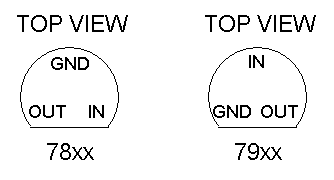
2) Missing bypass capacitors, or improperly placed filter capacitors
Often times the bypass capacitors are left out of the regulator circuit. They must be in place in order to keep the regulator from oscillating and overheating. At a minimum, a U10 (0.10uf) capacitor must be placed on the input to ground pin as close as possible to the device and with as short leads as possible. This is all that is really necessary to stabilize the device. This does not have any bearing on the value of the filter capacitor on the input. This capacitor will smooth any ripple coming from a rectifier in an AC power supply. The value of the filter capacitor should be large enough to handle the load without ripple in the input. This web page will not go into detail with the calculations. However, as a general rule, the larger the value, the better. Do not attempt to put a large value filter capacitor (C3) on the output of the regulator. In fact, you really don't need any filter capacitor on the output of the regulator. It is not necessary and could damage the regulator if the input voltage drops quick and below the output voltage. If it is imperative that you use a large value on the output, or if sub circuitboards have filters on them, a 1N4001 (CR2) across the input and output of the regulator with the cathode to the input as shown below.
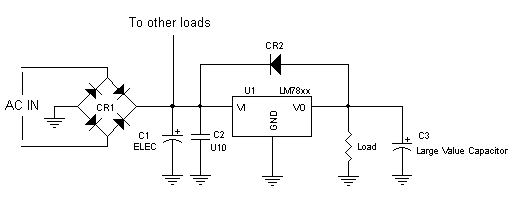
What does the diode CR2 do? If other loads on the rectifier side are heavier, the voltage on the input to the regulator will drop too quickly if there is a large capacitor (C3) on the output. This will backfeed into the output of the regulator and destroy it. The diode will pull the output voltage down to the input voltage if the input goes low quickly thus protecting the regular from being backfed.
3) Excessive dissipation
Proper design of the regulator is vital when using the regulator. The datasheet for the typical 7805 states it can regulate up to 1 amp or 5 watts. This is an absolute maximum rating and cannot be exceeded. It does not mean you can use a 24 volt power supply and expect to get 5 volts at 1 amp out of it. Let's see how they come up with the stated specification. In order to provide good regulation, you must have at least 3 volts above the regulated output. With an 8 volt power supply and a 1 amp load, and using the formula P=E*I, the regulator will dissipate 3 watts.
.... The high temperature on the regulator is caused by excessive power dissipation of the device. A standard TO-220 device can dissipate up to five watts and must be adequately heatsinked. Five watts dissipation in free air is actually too hot to touch.....
Let's look at a typical regulator circuit and see how much the regulator dissipates:
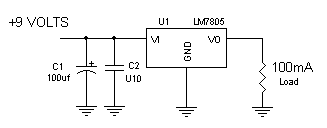
The above regulator circuit shows a 5 volt regulator with a maximum load of 100 mA (0.1 amps). The following is a diagram showing the relationship of voltage, current and power dissipation using the formula P=E*I.

As you can see, the regulator is dissipating 400 milliwatts (0.4 watts). The regulator will become warm to the touch. Next we will see how much power the regulator will dissipate if the power supply is increased to 12 volts.
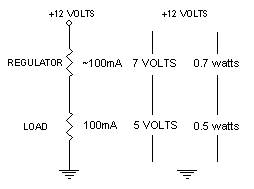
As you can see, the regulator is now dissipating 700 milliwatts (0.7 watts). Now the regulator is getting hotter. Let's increase the power supply to 15 volts.

The regulator is now dissipating 1 watt. The regulator is now too hot to touch, and will require a heatsink in order to release some of the heat built up on the package. If the regulator gets this hot or hotter, the regulator may shut down in order to protect itself.
Updated September 15, 2020